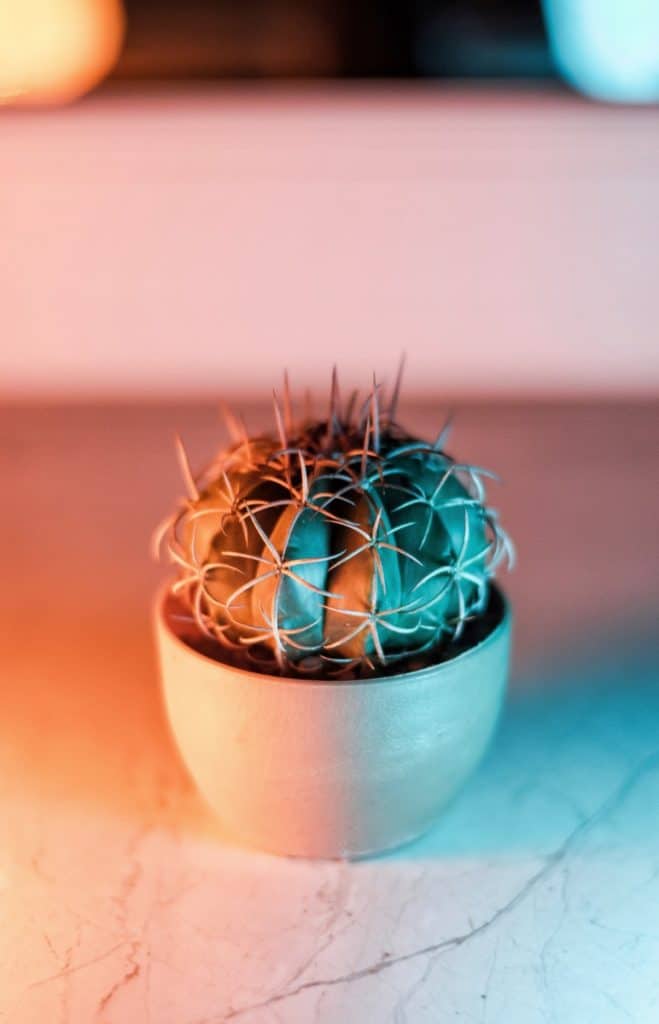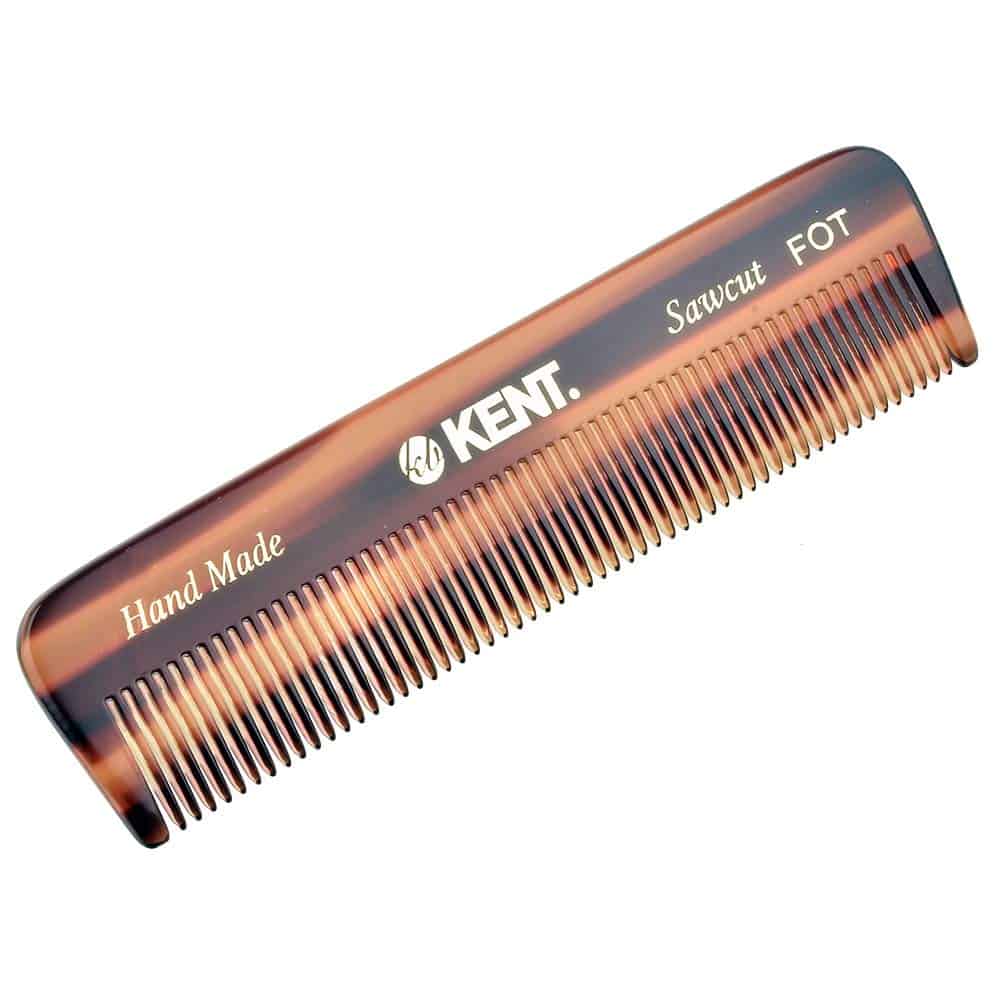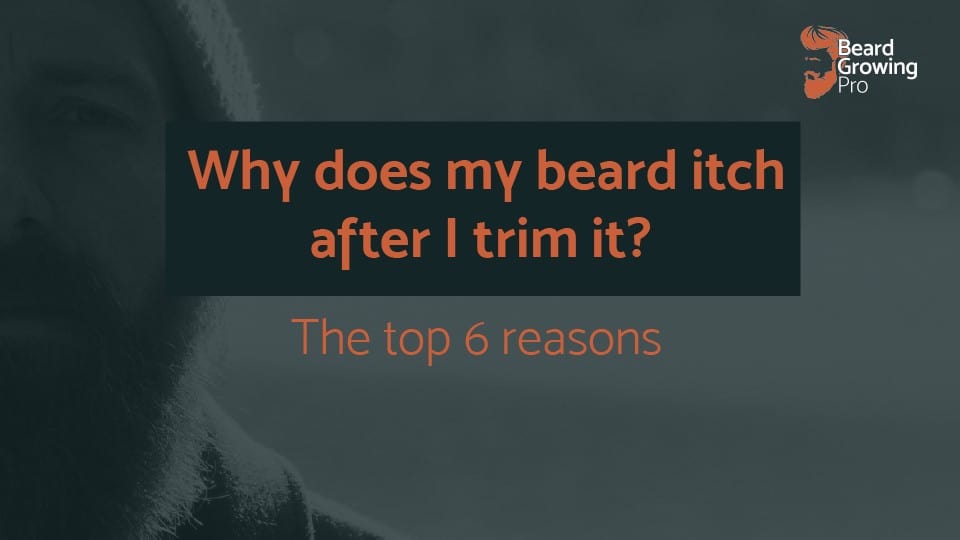Beard itch is something that plagues many a beard grower. It can happen while growing, while trimming, and can pop out of nowhere. One of the most annoying places it appears is after a good trim. There can be a variety of reasons why your beard mate itch after you trim it. Here, we are going to go through the top six reasons why your beard will itch specifically after a good trim. The good news is, that each of them has an easy fix.
Your beard itch is after you trim it because of dry skin, the sharp freshly trimmed hairs curling back to the skin, irritation from blades, cut hair trapped in your beard after trimming, excessive heat from hair drying, and irritation on the surface of your skin from aggressive combing and brushing.
Now let’s take a look at each of the individual reasons and what you can do to stop it.
Dry skin
There are two major causes of dry skin under your beard. The first one is under moisturising and the second is a fungal infection. The fungal infection is much more serious and may require medication. Dry skin occurs under your beard when you use harsh facial cleaning products as they remove the natural oils that are produced by your skin such as sebum. Dry skin can also be caused by environmental conditions such as harsh sun and dry cold weather.
One of the most un-talked about reasons is the fungus lurking inside your beard.
Fungal infections occur under your beard because it is the perfect warm, moist, dark environment for it to grow. Sunlight normally kills this fungus but in the depths of your beard they live happily. If you want to find out more about beard fungus and bacteria check out my other article – click here – where I go through common beard bacteria is and what you can do about them.
How to combat dry skin
The good news is there are plenty of ways to combat dry skin. And it all starts with a good beard shampoo. Washing your beard is the proper first step to laying the foundations for an awesome conditioned beard. If you want to find out about my top 10 beard soaps check out my other article – click here – for a full run down and review of the best commercially available soaps and some DIY soap recipes.
You have to choose a shampoo or soap that has been specially formulated for beards. Using hair shampoo on a beard will strip too many of the natural oils away from your face. Even if you use a dry formulation had shampoo. Other than using a great beard soap and shampoo you can look at conditioning your skin and beard.
A great beard conditioner can come in a variety of formats. It can come as an oil, balm, butter or a dedicated beard conditioner. If you want to have a look at some of the best beard conditioner is on the marketplace check out my other article – click here – for a complete run down of the best beard conditioner is available right now.
Here are some of the best reasons that you should consider using a dedicated beard conditioner:
- It nourishes and moisturizes the beard – one of the biggest benefits to your beard – it makes it lovely and soft and will make your wirey hair much easier to manage.
- It helps softens the stubble on the face – If you are not one for growing a long beard but prefer to keep it close to the skin the it’ll help soften the ends of the hairs and make it way less spikey!
- Imparts a healthy shine – A well-conditioned beard is one with a nice healthy shine to it. If you want to find out more tips and tricks to making your beard shine – check out my other article.
- It makes combing and styling easier – having hair that doesn’t grip the comb and sits well after it is brushed into place is an achievable outcome if you use a beard conditioner regularly.
- It reduces irritation and dry skin – the skin under a beard is not easy to look after. However, the regular use of a conditioner will leave the skin nourished and irritation-free. If you are worried about bacteria and a smelly beard you can also use a beard conditioner with essential oil that has antibacterial properties.
- They leave a nice fragrance -The last and maybe one of the strongest effects noticed by others is that a good beard conditioner will leave your beard smelling lovely! Choose a beard conditioner that has a smell that you like and, if you have a significant other, make sure that they also like the smell! There is nothing quite like a lovely smelling product!
Looking after your beard and the skin underneath it will mean that you will no longer have dry, flaky, itchy or brittle hair. It will look nourished and full and I promise you it will be worth the effort.
Sharp curly hairs

After you have trimmed your beard the hairs that you have trimmed our pointy and sharper than before. As hair grows it naturally tapers to a point. However, as you trim it you will be making a sharp and needle like end that can irritate your skin.
This can be a particular problem if your hair is dense and curly. Often seen in men with African heritage. The dense curly hairs mean that more of the ends of the hair are lying against the skin. So, if you are finding that immediately following a trim your face is unbearably itchy it could be that you need to soften the ends of the hair that you have just cut.
How to soften sharp hairs
There are a few ways that you can soften a sharp hair from trimming. These are three of my favourite ways:
- hot towel treatment – when you go to the barber you commonly see before shaving a hot towel treatment. This involves using a towel wrapped in hot water and wrapping it around the face. This softens the hair and makes it easier to cut. You can use this same approach after trimming your beard. Take a hot towel and soak it in water as hot as you can bear. Then drape it over your beard and moustache for at least 10 minutes. This will soften the hair. Be careful because warm wet hair is easier to break so no harsh brushing.
- Beard conditioner and treatment – use a dedicated beard conditioner, like above, to soften the hairs and cause them to bend rather than poke into your skin. You can use a beard oil, balm, butter, or dedicated beard conditioner whatever you wish.
- Use a deep hydration treatment – a deep hydration treatment involves using beard oil and a beard cover to deeply hydrate the beard over the course of about 30 minutes. You should take your beard conditioner or oil and apply it generously to your beard hair. Then take a shower or beard cap and cover up the beard for at least 30 minutes. Then rinse out the oil and shampoo and conditioner as usual. This will need to be repeated to times a week to keep your hair super soft.
Beard hair can be particularly thick and strong which makes it perfectly sharp after trimming. Follow the three steps above and your beard will no longer be sharp and needle like.
Irritation from blades and guards
When you are trimming your beard there is no doubt that you pass the tremor and guard over your face a lot. Most blades are made from metal and guards can also be metal or plastic. If you are a particularly aggressive tremor the blades and guards may irritate your skin. This can be because you are pushing down too hard on the skin while trimming – I think we have all done at some point.
I know that when I trim my beard, I’m particularly aggressive under the chin, at the neck area, and on the jawline. That is where the contours of my face change the most and I feel like I need to push hard to get into all the curves. Here’s what you can do to stop irritation from blades and guards:
- Use plastic guards – if you’re beard trimmer has metallic guards or a metallic tremor consider using a guard that is plastic and is less likely to scratch the surface of your skin.
- More and lightly – instead of trying to cut all of the hairs in one go try multiple passes without pushing down on the skin too hard. Go over your face in a multitude of different directions, up, down, diagonally, and sideways remembering a light touch.
Hard metallic and hard plastic guards can exacerbate already irritated skin. So if you have changed your trimming style and you have not seen an improvement. Look at other reasons your skin could be irritated.
Hair trapped in beard after trimming
If you have trimmed your beard before you all know how messy it can get. As you are trimming loads of hairs fly off in every direction. Some of these hairs get trapped in your beard. This means that not only do you have the razor-sharp edges from hairs still attached to your face, but you also have the freshly trimmed ends lodged in your beard. If this happens to you, they can easily irritate the surface of your skin and cause extreme itchiness.
The only way to deal with this is to brush your beard hair thoroughly after trimming. Also, you should use a hairdryer to blow out the trimmed off bits of hair from inside your beard. Feel free to use the highest power possible.
Do this after every single trimming session and it is likely that your beard will become less itchy.
Heat from hairdryer
Before I trim my beard, I always give it a good shampoo and condition with a dedicated beard soap and conditioner. This means that before trimming I need to dry my hair thoroughly. I use a two-step process to dry my hair:
- gentle towel drying – when your hair is wet it is at its most fragile. So do not go to town on your face with a towel. You will end up breaking off more beard hairs. However, using a nice microfibre, super absorbent, towel to pat your face gently you can dry it out.
- Hairdryer – I use a two-step process when drying my beard hair. Firstly I use a medium to high heat on a low-power setting to remove most of the moisture. Then, I switched to a low heat and low-power setting to finish off the drying process. Throughout this entire process, I am combing and brushing my hair into the shape that I wanted and following the comb with the hairdryer.
The hairdryer aspect is where you can run into trouble.
Using a hairdryer that is too hot on your face you can cause itchiness and flakiness. It can quickly dry out your beard and cause it to become excessively itchy.
To overcome the issues associated with a hairdryer that is set too high or you have to do is be mindful of the amount of heat that you are exposing your beard hair to. If you have any issues with your beard and you’re not sure what temperature to use, you should use the lowest heat setting or a cool setting while drying your beard. Do this and then check to see if your beard is not as itchy.
Aggressive combing

Finally, one of the most common irritants for skin under a beard is the pointy ends of a comb. When we are brushing and maintaining our beard hair we can often become over aggressive. I know that I can become particularly aggressive if my beard is not doing what I want. Using a plastic or metallic comb can make the problem even worse as these hard materials can easily scratch up the skin under the beard.
If you find that you are becoming overly aggressive while combing, you can choose a wooden comb with a wide tooth. The wide tooth will reduce the amount of pressure that you can apply to your skin and the wood will be kinder on your face.
You can also opt to use a rounded a bristle brush which will reduce the amount of pressure you can apply to your beard. This will force you to focus on maintaining the hairs rather than scraping through the entire thickness of the beard.
If you find that you have a particularly large hair fall during combing you could be an aggressive comber.
Therefore, just approached the combing session with a little more calmness and softness in till you are no longer seeing a lot of hair full.
These six reasons are the most common – however if you are still finding that your beard is itchy after trimming – look in detail at your grooming and maintenance routine to see where you could be inflicting dryness or irritation to your skin. Alternatively, after looking at all of these options, you may find that nothing works for you. In this instance, seek out the advice of a dermatologist so that you can remove beard fungus and bacteria from the potential causes. If you do have a fungus problem, the dermatologist and/or doctor will be in a position to help you remedy the situation.
Now, let’s take a look at the most frequently asked questions around beard itchiness.
Frequently asked questions
beard itch is something that nearly every beard grower faces at some point in time. Here are the most frequently asked questions and answers with references to other articles that may be useful for you.
How to stop beard itch
To stop beard itch you should consider upping your hygiene and exfoliating the skin under the beard as often as possible. Use a good conditioner and beard soap when shampooing your hair. And look towards other beard products that can help alleviate itchiness. That includes beard oil, beard balm, beard butter, and a dedicated conditioner.
Beard itch home remedy

For a full rundown on the best itchy beard home remedies check out our top eight on my other article – click here.
Here are the best beard itch home remedies for dry irritated skin – and can be used after trimming your beard:
- Clay – clay is one of the most effective ways to calm irritated skin but make sure that it is pure and doesn’t contain any other ingredients. For example, you need a special facial clay not the stuff you make pots from. Green clay is the most useful type to ease irritation. You need to mix the clay with water to turn into a peanut butter like consistency and then use this to rub into the base of your beard. Leave it on for as long as you can and then wash it out.
- Apple cider vinegar – apple cider vinegar contains citric acid which is capable of removing bacterial growth and fungus. It helps relieve itching by balancing the pH levels of your skin too. To use it, add 1 mL of apple cider vinegar to 10 mL of water and mix it well. Rinse your beard thoroughly and then rinse out. Don’t leave it next to your skin for too long because it is acidic in nature.
- Aloe Vera – Aloe Vera has a huge array of benefits including hydration, promoting healing, and reducing infections. You can simply rub the gel into the affected areas of your beard with clean hands and you should notice the effects within one minute. Rinse your beard thoroughly afterwards and you will have an itch free beard.
The great thing about these home remedies is that is almost certainly one of these available to you right now.
Conclusion
So, there are all of the reasons why your beard may be itchy after you trim it. Importantly beard itch isn’t something that you have to live with and there are a variety of ways to get rid of your beard itch. Remember, that if none of these work for you, go and see a medical professional like a dermatologist or doctor.
Removing itchiness should be the first thing that you do while growing a beard as it will ensure that you are around for your beard growing journey. Resist cutting off as long as possible and you will be happy with your new longer and itch free beard. Happy beard growing my beautiful friends…



